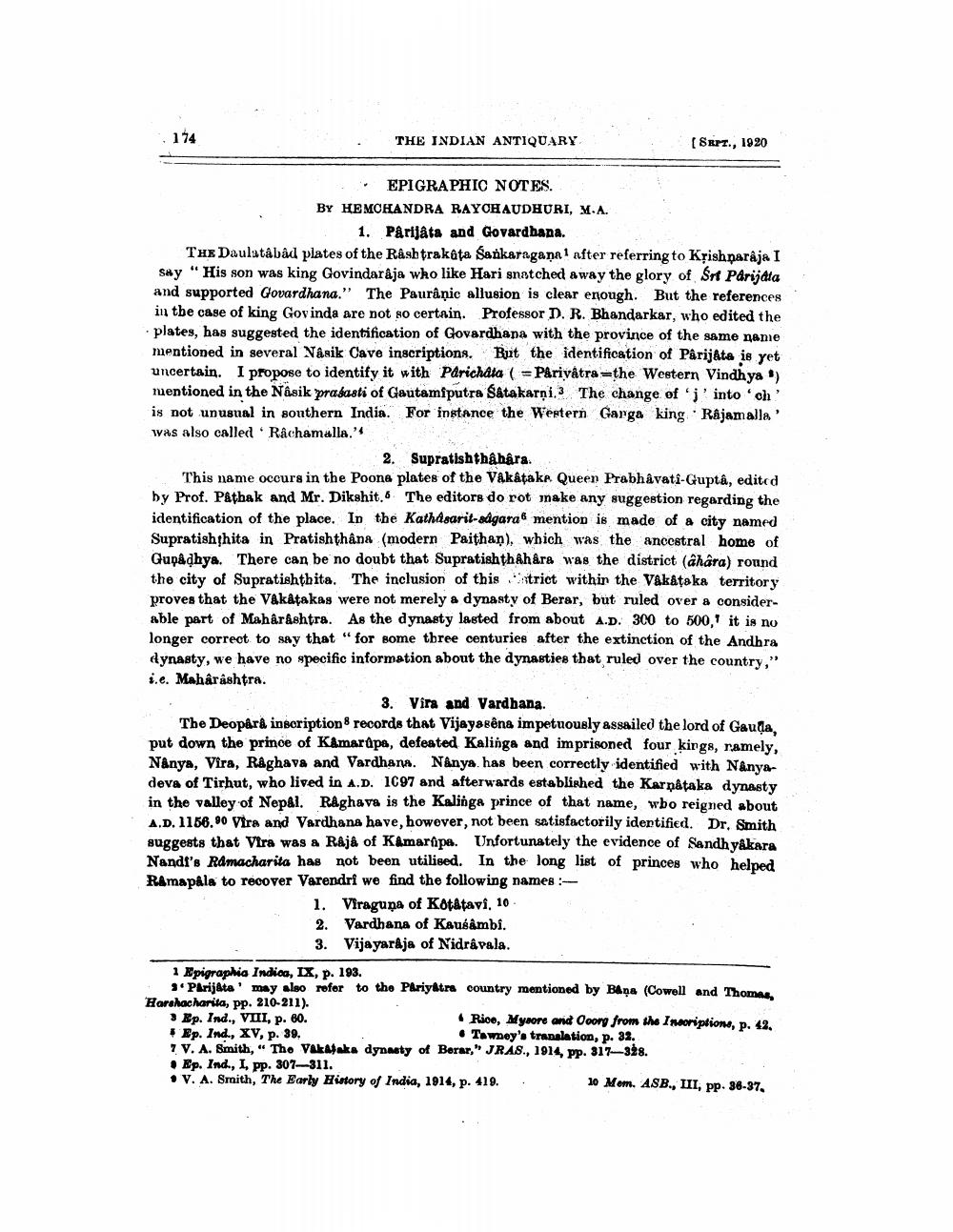________________
174
THE INDIAN ANTIQUARY
[SEPT., 1920
EPIGRAPHIC NOTES.
BY HEMCHANDRA RAYCHAUDHURI, M.A.
1. Parijata and Govardhana.
THE Daulatâbâd plates of the Rashtrakuta Sankaragana 1 after referring to Krishnaraja I say "His son was king Govindaraja who like Hari snatched away the glory of Śrt Parijata and supported Govardhana." The Paurânic allusion is clear enough. But the references in the case of king Govinda are not so certain. Professor D. R. Bhandarkar, who edited the plates, has suggested the identification of Govardhana with the province of the same name mentioned in several Nasik Cave inscriptions. But the identification of Parijata is yet uncertain. I propose to identify it with Parichata (Pârivatra the Western Vindhya) mentioned in the Nasik prasasti of Gautamiputra Satakarni.3 The change of 'j' into 'ch' is not unusual in southern India. For instance the Western Ganga king Rajamalla' was also called Râchamalla.'
2.
Supratishthâbâra. This name occurs in the Poona plates of the Vakâtake Queen Prabhavati-Guptâ, edited by Prof. Pathak and Mr. Dikshit. The editors do rot make any suggestion regarding the identification of the place. In the Kathasarit-sagaras mention is made of a city named Supratishthita in Pratishthâna (modern Paithan), which was the ancestral home of Gupadhya. There can be no doubt that Supratishthahara was the district (âhâra) round the city of Supratishthita. The inclusion of this strict within the Vakataka territory proves that the Vakatakas were not merely a dynasty of Berar, but ruled over a considerable part of Maharashtra. As the dynasty lasted from about A.D. 300 to 500, it is no longer correct to say that "for some three centuries after the extinction of the Andhra dynasty, we have no specific information about the dynasties that ruled over the country," i.e. Maharashtra.
3. Vira and Vardhana.
The Deopârâ inscriptions records that Vijayasêna impetuously assailed the lord of Gauḍa, put down the prince of Kamarapa, defeated Kalinga and imprisoned four kings, ramely, Nânya, Vira, Raghava and Vardhana. Nânya. has been correctly identified with Nanyadeva of Tirhut, who lived in A.D. 1C97 and afterwards established the Karnataka dynasty in the valley of Nepal. Raghava is the Kalinga prince of that name, who reigned about A.D. 1156.90 Vira and Vardhana have, however, not been satisfactorily identified. Dr. Smith suggests that Vira was a Raja of Kamarûpa. Unfortunately the evidence of Sandhyakara Nandi's Ramacharita has not been utilised. In the long list of princes who helped Ramapala to recover Varendri we find the following names :
1.
Viraguna of Kôtâtavi, 10
2. Vardhana of Kausâmbi.
3. Vijayaraja of Nidrâvala.
1 Epigraphia Indica, IX, p. 193.
'Parijata may also refer to the Pariyâtra country mentioned by Bana (Cowell and Thomas, Harshacharita, pp. 210-211).
3 Ep. Ind., VIII, p. 60.
Ep. Ind., XV, p. 39.
7 V. A. Smith," The Vakalaka dynasty of Berar," JRAS., 1914, pp. 317-328.
Rice, Mysore and Coorg from the Inscriptions, p. 42. Tawney's translation, p. 32.
Ep. Ind., I, pp. 307-311.
V. A. Smith, The Early History of India, 1914, p. 419.
10 Mem. ASB., III, pp. 36-37.




